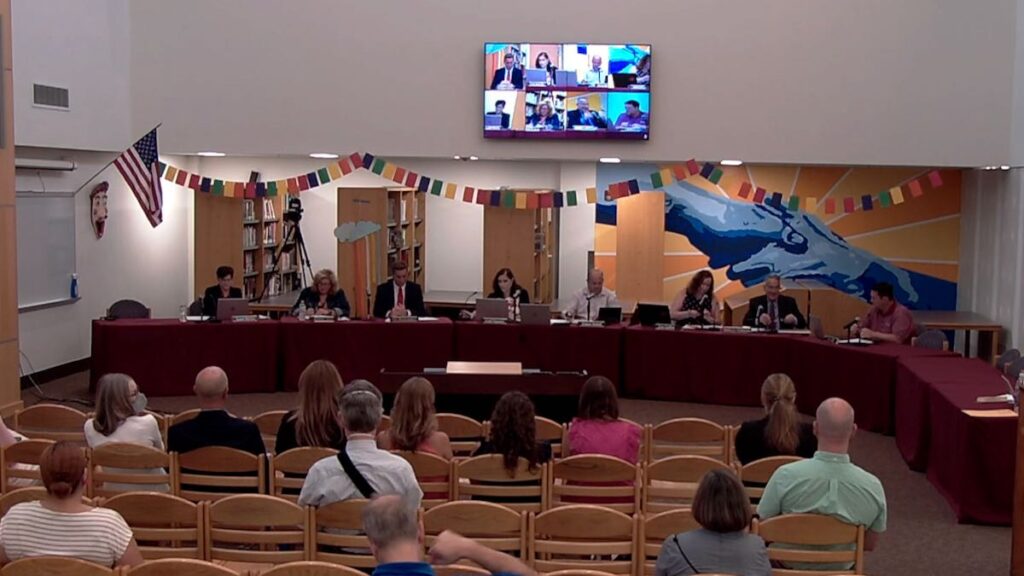
Reading, MA — After greeting the district’s new hires prior to the beginning of the new term, the School Committee focused considerable energy on Monday night reviewing the need for a new Killam Elementary School. Director of Facilities Joe Huggins said that the current structure, built in 1967, has been well-maintained over the years but has never had a significant renovation. The building did receive a new roof in 2010, as well as some new windows and an update to the heating system as a part of performance contracting. Still, it is not compliant with the Americans with Disabilities Act (ADA) nor does it contain a modern fire suppression system. Huggins continued to explain that the building has lead in the drinking water, is not energy efficient, there is water infiltration through the foundation, and it has poor sight lines to the front door from the main office, creating a security concern. Some classrooms can only be accessed through other classrooms.
Huggins confirmed that the building would continue to be maintained as it is, but several large projects are required to update the building. Huggins continued, stating that if the cost of those projects reaches 20 percent of the value of the building, then regulations regarding ADA compliance and other issues will force even higher costs. School Committee member Chuck Robinson, recognizing the need for significant updates, commended Huggins and his team for their efforts stating, “The building still looks immaculate.”
School Committee Packet
School-Committee-Packet-060822Killam principal Sarah Leveque continued the discussion, sharing the complexities of using the building programmatically. Leveque detailed the conversion of closets to learning spaces with no windows and poor ventilation. She also stated that some staff share office and therapy space, that there are few areas for small group work or instruction, and that space for educational interventions is sub-standard, often requiring the use of hallways. “We want a space where [tier 2] students feel protected and welcome to learn,” Leveque indicated. “We are doing the best we can with what we have,” Leveque concluded.
While praising Leveque and the staff at the school for their creativity, school committee member Thomas Wise indicated that the needs are clear. “Six to seven years with lead in the water is not acceptable; staff in closets is not acceptable; classrooms in locker rooms are not acceptable; the space for special education is not acceptable,” Wise declared. “The design of the building is outdated from an educational perspective.”
School Committee member Erin Gaffen agreed, “Some people are a little distracted by the enrollment,” Gaffen indicated. “It’s not about if our numbers have changed in the last decade-plus, but that our students have changed and how we are meeting our students’ needs has changed.” Member Carla Nazzaro added, “This is not just a Killam issue; this is a problem for the district.” Leveque agreed, “When we make an investment in one of our schools, we make an investment in all our schools.”
Dale Gienapp of Gienapp Architects, project consultant for the proposed project, updated the committee on the process, which got them to this point. Gienapp shared that the process began with an enrollment study conducted by the New England School Development Council, which projected increased enrollment of 115 students in the elementary program over the next twenty years. There is also an anticipated increase of 110 Pre-K students during that time. Gienapp also noted that seventeen classrooms had been set aside in the last fifteen years for special education purposes, nine for kindergarten, and three for pre-kindergarten. These factors together create an anticipated 35% space shortage in elementary schools in the coming years. Gienapp also indicated that the increased use of computers in education and changes in school libraries and multimedia centers have created space needs. This information led to developing a master plan in which seven options for increased space capacity were submitted to the School Committee for discussion.
After review, the School Committee opted for a choice that will build a new Killam Elementary School. A letter of interest was submitted to the Massachusetts School Building Authority (MSBA) requesting to be included in its funding program. Gienapp shared that the MSBA received 188 letters of interest and that Reading is one of only 17 selected to continue in the process. June 1, 2022, began a 270-day eligibility period during which the town needs to complete several tasks, including establishing a School Building Committee, reports on programming and maintenance, and funding a feasibility study and schematic plan.
Susan Bottan, Director of Finance, reported that the required Educational Profile Questionnaire and the online enrollment projections report had been filed before the deadline.
As a next step, Town Meeting will be asked in November to appropriate $2.2 million from free cash for the feasibility study and schematic design. Robinson inquired what the town would get for the investment of $2.2 million. Gienapp shared that the $2.2 million will pay for design fees, the testing of the site for viability, and other factors such as traffic and contingencies. Robinson confirmed with Gienapp that while the money will be spent upfront, it will be included in the overall total, which is reimbursable by the MSBA at the project’s completion. The School Committee will hold a public hearing on September 8 to receive additional input from the community on the project.
Superintendent of Schools Thomas Milaschewski presented his “start of school update,” including new COVID-19 protocols in the district. If students test positive for COVID, those pupils may return to school after six days, provided they are symptom-free or asymptomatic. They will have to remain masked until the eleventh day after the positive test. If students are exposed to COVID, they will be asked to mask for ten days. Testing will be available in the schools, and the district will continue to report cases on its website. Milaschewski shared that these protocols align with Department of Elementary and Secondary Education and Department of Public Health guidelines but are “likely to shift throughout the year.”
Milaschewski thanked the community for the continued implementation of the new math curriculum and the new literacy curriculum purchased using American Rescue Act Plan funds. He highlighted the opening of the academic support center and the new dual-enrollment courses at RMHS. He also expressed excitement about the additional 40 METCO students who will be attending Reading Public Schools this year.
Milaschewski introduced new Food Services Director Katie Franzetti to the School Committee. Franzetti recently worked for the Boston Public Schools and impressed the hiring committee with her ability to articulate future vision for the meal programs in the schools, as well as her ability to develop relationships with community partners.
Milaschewski reported that the district is still looking for paraeducators, tutors, cafeteria workers, and substitute teachers. He asked that members of the community consider filling some of these roles. “We are thrilled to see our students back on Wednesday morning,” Milaschewski concluded.
New Parker Middle School principal Rochelle Rubino shared proposed updates to the student handbook at her school. These were reached through a collaboration between students, staff, and parents and resulted from an equity audit. Potential changes include more inclusive language, restorative, as opposed to punitive, discipline practices and dress code updates that support student expression. Gaffen indicated that she appreciated the updates stating, “I think [they] are a standard that I hope other schools will follow.” Wise stated that there was some inconsistency with the terms “parent/guardian” and “caregiver” and that caution must be taken to follow the language in the applicable laws when appropriate. Milaschewski also indicated that there was work to come in creating consistent district-wide handbook language for all the schools.
RMHS principal Kevin Tracey also shared some work that has been accomplished on the high school handbook. Tracey indicated work had been done on the attendance policy and on the language for the code of conduct. Tracey also shared the concept of “social probation” as an alternative to suspension, which would still address severe behavior, but will keep students in school. “Consistency is key,” Tracey added. “It will lead to more clarity for parents and students and also aid in enforceability.”
The School Committee concluded the meeting previewing plans for a new school district website. The committee adjourned at 10:40 pm.

